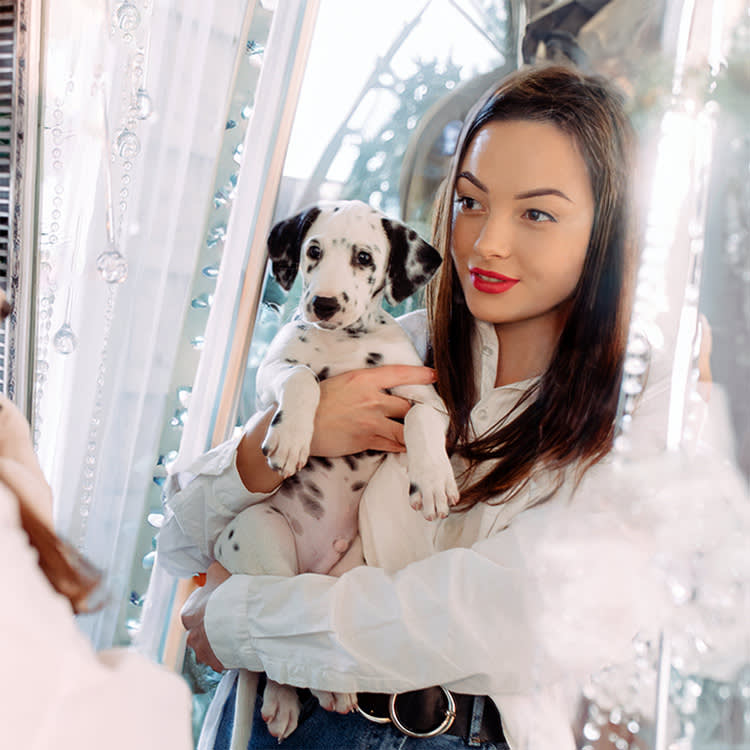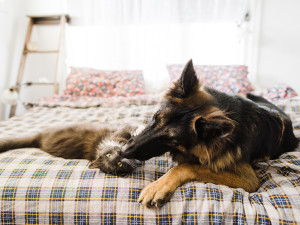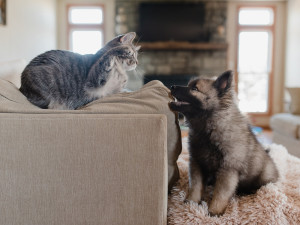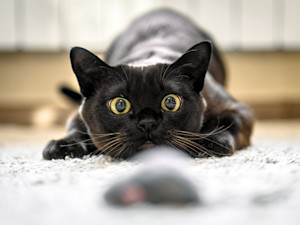Do Dogs and Cats Recognise Themselves in the Mirror?
Mirror, mirror on the wall, who’s the cutest of them all?
Ever seen your pet gazing at their reflection in the mirror and wondered what’s going on in that furry little head of theirs? Us too. So we did some digging about what cats and dogs see when they look in the mirror.
We know that dogs and cats recognise other people and petsopens in new tab. Dogs have furry best friends that get their tails wagging. Cats remember the people who feed and care for them. But do they know what they look like? When confronted with their reflection in the mirror do they know who’s the cutest of them all or are they confused by the animal staring back at them?
Get (totally free) deals for food, treats, accessories, tech and way more pet parenting must-haves.
Cats are from Mars and dogs are from Venus
Cats and dogs can be as differentopens in new tab as, well, cats and dogs. Behaviour-wise, dogs are more likely to be excitable and cuddly, whereas cats hold themselves aloof.
Most cat and dog parents will agree their pets’ differences extend to how they react to mirrors, too. For example, my Lakeland Terrier, Bramble, used to try and play with his mirror friend while my cat eyes his reflection with thinly veiled hostility.
Royal College of Veterinary Sciences member Dr Kathryn Dench agrees that dogs and cats often have contrasting responses to seeing themselves in a mirror. “Around 80% of dogs will initially show social behaviours such as barking or play postures when they see their reflection,” she explains. Dogs also lose interest in their mirror pals quite quickly.
In contrast, cats are more likely to approach a reflection cautiously and spend some time checking it out (if your cat is anything like my cat Cosmo, he harbours an aloft sort of confusion about his mirror image).
It’s obvious from these typical reactions that both cats and dogs are interested in the potential friend or foe they see in the mirror. But Dr Kathryn pointed out that their curiosity doesn’t “conclusively prove self-recognition” – from simply watching cats and dogs interact with their reflections, it’s not obvious whether either is aware that they’re looking at their own face.
The mirror test holds the answers
The ‘mirror testopens in new tab’ is commonly used to see if animals have the ability to recognise themselves in a reflection and is also considered a good measure of animal intelligence. During the mirror test, which was developed by psychologist Gordon Gallup in 1970, some kind of colourful sticker is put on the animal in a place they can’t usually see (like their forehead). The animal is then shown their reflection in the mirror.
If the animal sees the mark in the mirror and then touches the spot on their body, it suggests the animal is capable of self-recognition. Similar to how we would go to a mirror and rub off a smudge of ink we notice on our cheek, it proves the animal connects the image they see in the mirror with their own body.
So far, only these non-human species have passed the mirror test: chimpanzees, bonobos, gorillas, Bornean orangutans, bottlenose dolphins, killer whales, Asian elephants, the cleaner wrasse fish, and magpies.
Dogs, however, usually react playfully or attempt to fight their reflectionopens in new tab, not noticing the sticker; and cats are either indifferent, curious or hostileopens in new tab towards their reflection, suggesting neither recognise themselves in the mirror.
Mirrors to the soul
Despite knowing he wouldn’t pass the mirror test, I still think Cosmo is the smartest little guy there is. I’m sure lots of pet parents would agree; while our pets have moments that can only be described as wacky, they also surprise us by responding to our voices, actions, words and more. Cosmo never misses the rustle of the food packet or the scrape of the fork on his bowl, for example.
Knowing what we do about cats and dogs, some scientists are beginning to question the mirror test. “I would argue that self-awareness is a broader concept than [the mirror test]... even though they [dogs] don’t recognise themselves in the mirror – I find it hard to imagine that they have no awareness of themselves,” says primatologist Frans de Waalopens in new tab.
Cats, for example, rely heavily on their hearing, smellopens in new tab and whiskers to detect preyopens in new tab and are very nearsightedopens in new tab so have trouble seeing objectsopens in new tab up close; and for dogs, who are also masters of scentopens in new tab and soundopens in new tab, objects that are closer than 20–25cm will appear blurryopens in new tab – so it makes sense that a test that relies solely on sight should not necessarily be the mark of self-awareness.
Joshua Plotnik, an assistant professor of psychology at Hunter College in New York, agrees and isn’t sure if the mirror test is the best way to tell whether our pets can recognise themselves. “It doesn't mean that those animals that fail the mirror test don’t have self-awareness,” he says. “Because the mirror test requires an animal to pay careful attention to the reflection of their own bodies, it may not be a good test for animals that don’t use vision as a primary sense.”
Other ways to prove intelligence
There’s hope yet for our furry friends. In fact, tests that focus more on smell and taste have painted them in much better light. The ‘yellow snow testopens in new tab’, for example, proves that dogs can use their nose to recognise their own pee. For five years, Marc Bekoff, PhD, studied his dog Jethro’s response to pee-soaked snowopens in new tab (both his own and that of other dogs). Bekoff discovered that Jethro recognised and behaved differently around his own yellow snow versus snow yellowed by other dogs.
While one study isn’t enough to prove that all dogs have a sense of selfopens in new tab (ie, that they understand who they are separate from other animals and humans), it’s a good start and does prove a decent level of intelligence and awareness. There don’t seem to be similar studies looking at cats’ other senses when it comes to self-awareness, but plenty of experiments have confirmed our kitties to be intelligent beings over the years.
For instance, cats are thought to have brilliant memories, allowing them to use smells and other cues to find their way homeopens in new tab, even after a couple of years (I’m sure we’ve all heard stories of lost catsopens in new tab turning up on the doorstep years later). Cats have also been shown to understand object permanenceopens in new tab – they know their favourite toyopens in new tab still exists after you’ve put it out of sight and will sometimes look for it in that spot weeks later.
What does this all mean? Well, we shouldn’t question the intelligence of our beloved pets just because they don’t recognise themselves in the mirror. Cats and dogs look at the world through their other senses rather than their eyes, so it’s not super-surprising that they wouldn’t spot themselves in a scentless, soundless reflection. So, next time you see them pawing at, playing with, or avoiding their image, enjoy the show without worrying about their intelligence.





